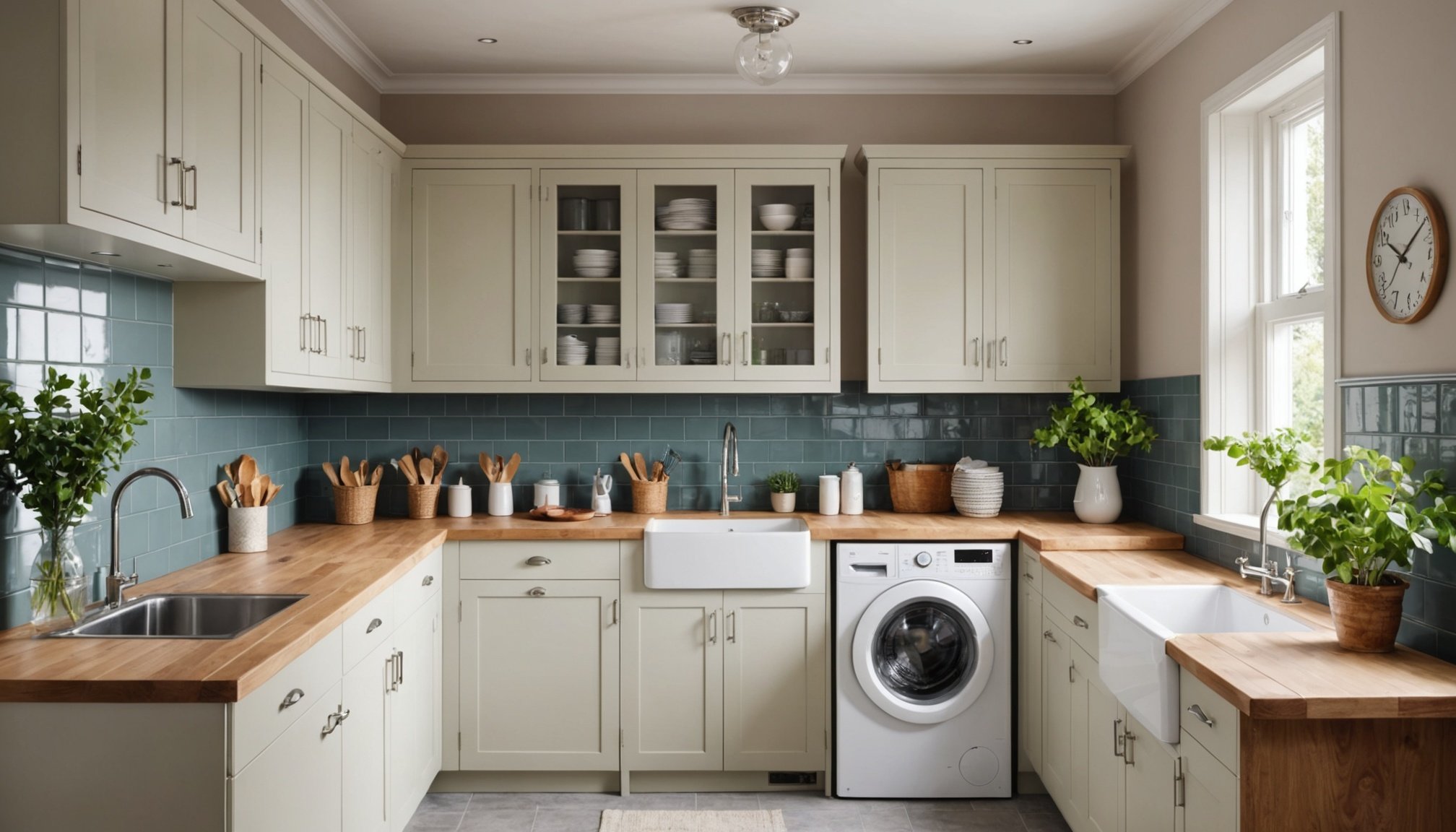Understanding the Need for a Laundry Space in the Kitchen
In modern UK kitchens, integrating a laundry space is becoming a design necessity. Laundry space integration offers a host of benefits, mainly due to the limited sizes of homes in the UK, where maximizing space is critical. This integration can remarkably enhance kitchen functionality by ensuring tasks are accomplished more efficiently.
Adding a laundry space within the kitchen is not just about functionality, it’s about convenience. It allows easier management of household chores, enabling one to multitask. With limited space, combining kitchen duties with laundry tasks offers an efficient workflow without a need to shuttle between rooms.
Also read : Maximize Your Space: Creative Storage Solutions for Small UK Flats
Furthermore, there are common issues when the laundry area is far from the kitchen. These include inconvenience in accessing the laundry space during cooking or dining times, leading to delays and increased effort. Traveling between separated areas can also increase the risk of spillage or mishaps. Having the laundry space integrated into the kitchen mitigates these issues by placing everything within reach.
The design necessity of incorporating a laundry space becomes clear when considering the lifestyle demands and spatial constraints in the UK, offering a practical yet stylish solution to improving daily chores.
Also read : Stylish Storage Solutions to Tidy Up Your UK Hallway: Balancing Elegance and Organization
Design Considerations for a Combined Laundry and Kitchen Space
Creating a combined laundry and kitchen space demands careful planning to ensure the functionality and aesthetic harmony of this multifunctional area. Integrating these two spaces requires innovative kitchen design strategies to optimize layout and storage while maintaining a cohesive look.
Popular layout options include L-shaped and galley designs, which offer seamless integration by making efficient use of space. These layouts provide ample room for kitchen appliances and laundry machines, streamlining workflow. Another smart option is an island containing a washer or dryer, which centers all activities around a communal hub.
Design principles focus on achieving a balance between aesthetics and practicality. Choosing a unified colour palette and materials helps maintain visual continuity. For instance, incorporating the same cabinetry style across both areas unifies the design.
When selecting finishes and fixtures, emphasize those that serve dual purposes. Durable countertops, such as quartz, handle both culinary and laundry tasks without compromising on style. Additionally, opting for energy-efficient appliances with quiet operation enhances functionality without disrupting kitchen activities.
By combining thoughtful design elements with practical layout choices, it’s possible to create a multifunctional space that feels expansive and organized, meeting the diverse needs of modern living.
Innovative Storage Solutions for Laundry in the Kitchen
Integrating laundry functions into kitchen space may seem challenging, yet with practical storage ideas, it’s entirely feasible. Maximizing available space hinges on efficient organizational solutions. Leverage cabinetry by installing shelves to house detergents and cleaning supplies. Pull-out drawers can hide hampers efficiently, ensuring that the kitchen remains tidy and functional.
Space-saving measures continue with the strategic use of appliances. Consider stacking washer and dryer units if space allows, freeing up room for other uses. Compact, front-loading machines can also double as countertops when not in use, adding to the versatility.
Stylish bins play an equally significant role, cleverly merging functionality with aesthetics. Clear, stackable bins allow for easy visibility of contents while maintaining a clean look. Consider bins in muted colours that complement common kitchen décor themes like wood textures or metallic finishes, offering a seamless blend of style and practicality.
Hamper design is another aspect not to be overlooked. Opt for slim, rectangular hampers that can fit snugly into narrow spaces or under shelves. Choose materials like wicker or fabric that mirror the kitchen’s decorative elements, to keep the overall look cohesive.
Employing smart solutions brings harmony and efficiency to the kitchen-laundry hybrid, achieving both order and elegance.
Incorporating Necessary Appliances: Choosing the Right Fit
Selecting laundry appliances that balance performance and practicality in a kitchen setting can be challenging. To begin with, it’s essential to understand the importance of space compatibility. This means not only ensuring that your appliances physically fit into your available space but that they integrate well with your lifestyle and needs.
When considering the size and capacity of washers and dryers, assess your typical load sizes. Compact models are excellent choices for smaller households or if space is limited. They are particularly advantageous in apartments where conserving room is crucial. Alternatively, stackable units offer a great solution when vertical space can be utilised, effectively doubling your laundry capacity without doubling the footprint.
However, size isn’t the only factor. Energy efficiency plays a crucial role. Appliances with high-energy ratings can significantly reduce electricity bills and are environmentally friendlier. Likewise, pay attention to noise levels, especially important in open-plan kitchens where the sound can easily travel. Selecting units known for quiet operations can maintain a peaceful home atmosphere.
In essence, the ideal appliance choice will strike a balance between available space, energy consumption, and the comfort of your living environment, tailored to meet your specific needs.
Aesthetics and Style: Harmonizing with Kitchen Design
Achieving a cohesive design in a kitchen that seamlessly integrates laundry appliances requires careful consideration of both aesthetics and functionality. To maintain visual harmony within the space, one must thoughtfully select color schemes and materials. Opt for hues and finishes that complement existing elements, such as cabinetry and countertops.
Approaches to Consistency
Some homeowners achieve consistency by prioritising similar design elements across both kitchen and laundry areas. By using the same color scheme and materials, such as matching tile work or coordinating cabinet finishes, one can achieve a unified look. This strategy also helps in creating a visual harmony that does not disrupt the flow of the space.
Embrace innovative solutions to disguise appliances. For instance, custom cabinetry can cleverly conceal laundry machines behind panelled doors, ensuring they blend seamlessly with the rest of the kitchen aesthetic. Additionally, utilising pull-out drawers to stow laundry essentials can enhance the perception of a tidy, uncluttered space.
Innovative Concealment Ideas
Emphasise a clean, inviting kitchen by integrating hidden storage solutions. Sliding panels or bifold doors can conceal appliances, allowing the space to appear uniform when not in use. This not only augments the kitchen’s functionality but also contributes to a tranquil and appealing environment, encouraging utility without sacrificing style.
Practical Case Studies: Success Stories in UK Kitchen-Laundry Combos
One fascinating approach to design success involves the seamless integration of kitchen-laundry combos. These case studies reveal innovative strategies that have transformed UK homes. Let’s explore some real-life examples and the creative approaches used.
A notable example is a compact London apartment where the homeowners faced a space constraint. By merging the kitchen and laundry in a single cohesive unit, they utilised vertical stacking for machines and introduced sleek cabinetry. The lesson learned here is leveraging vertical space effectively.
In another instance, a countryside cottage embraced a contemporary rustic design. The blend of traditional materials with modern appliances gave the space an elegant look while maintaining functionality. This case shows how balancing aesthetics with practicality can result in a harmonious setting.
Visual inspiration can be particularly motivating. Before-and-after transformations illustrate not just spatial improvements but also the overall enhancement of a home’s character. These cases often reveal ingenious storage solutions, clever lighting adjustments, and colour harmonisation to create welcoming environments.
Each of these success stories offers a unique perspective on overcoming typical layout challenges. They serve as an inspiration for homeowners looking to undertake similar projects, showcasing that with thoughtful design, kitchen-laundry combos can truly enhance home living experiences.
Navigating UK Building Regulations for Laundry Spaces
Renovating a laundry area requires understanding UK building regulations. These regulations ensure safety and efficiency, particularly in utilities-heavy spaces like homes. Initially, focus on regulations that pertain to electrical and plumbing setups.
When designing, consulting local regulations is crucial. UK compliance varies by location, impacting required standards. Engaging with local authorities early in the planning process aids in identifying specific regulations affecting your project. Compliance with these standards not only enhances safety but boosts the value of your home renovations.
Key considerations include proper ventilation, crucial for moisture control in laundry spaces. Incorrect ventilation heightens the risk of mould, compromising structural integrity and health. Additionally, ensure all electrical installations meet Part P of the Building Regulations, which govern electrical safety in dwellings.
While planning renovations, prioritise safety. A few tips to ensure compliance include hiring a professional contractor knowledgeable about local codes and regulations. This step guarantees your project aligns with UK building regulations. Moreover, integrating certified energy-efficient appliances can improve compliance and environmental footprint.
In summary, building regulations play a pivotal role in shaping successful home renovation projects. Prioritising compliance from the outset aids in creating safe, functional, and valuable living spaces.











